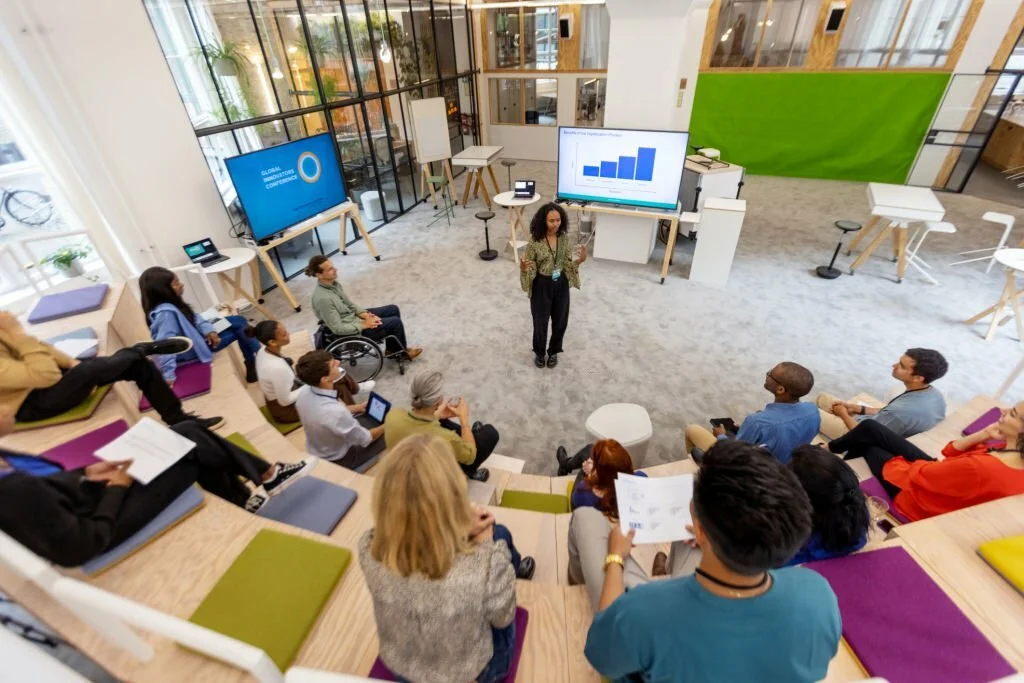How does the right choice of system relate to personal responsibility, the search for talent and continuous development in future organizations?
There’s a lot going on right now and it’s moving very fast – digitalization, new generations in the labour market and the search for talent. Many companies are working hard to adapt to the new fast-changing world. Being in the midst of digitalization is no easy task as it is about understanding, acting and choosing the right digital technologies that support and develop us and our relationships, and trying to ensure that all choices result in smart improvements, efficiencies and automation. At the same time, some say things are moving too fast and it’s too hard to keep up – people are getting burnt out, ill health rates are rising and companies are not delivering the same growth and performance as before. But what can you do to lay the foundations for a future organization that will be attractive to new talent seeking to join your company?
A Deloitte report published a few years ago asked what is important for today’s talent. At the top of the list were two things: ‘Organization of the future’ and ‘Learning and development’. My colleagues and I often talk about how companies should reflect how we humans behave in our digital everyday life and transform into a “true learning organization” which we see as a big part of the organization of the future. We believe that companies should offer good digital tools with really good knowledge here and now that meet the demands of employees today. Digitalization and streamlining are all well and good, but people and talent should be at the center.

But what does ‘organization of the future’ actually mean? If you were to start googling and asking around, you would probably get many different answers. I think at one level it’s about having a continuous process of change and a culture that is agile and flexible. At another level, it is about the organizational model itself. They talk about theories like Teal, Agile and Design thinking. I personally find Teal in particular very interesting. Fredric Laloux, an executive coach, spent years researching what made companies thrive and become sustainable and wrote a book about the results, Reinventing Organizations. He describes how many companies are already value-driven and thinking about employee ownership. But then he goes one step further and identifies a new type of organization. There are no managers, but everyone works in self-directed small teams with a deeper business purpose. The structure is not fixed but fluid, constantly changing and adapting to the different requirements and conditions.
I really got into many of the ideas when I read the book a few years ago as some of the elements of his theories seemed obvious. These include what he calls ‘Wholeness’, which is about bringing our whole ‘self’ to the workplace in order to use our full potential, creativity and energy. When discussing how employees should develop and learn new things, Laloux describes what many people are talking about today – employees taking responsibility themselves . The focus is on personal development and striving to build a shared culture. Long programs no longer exist, but continuous learning in the form of shorter skills courses open to all. These are tailored and designed mainly by colleagues – dedicated experts in the company who also act as advisors. The corporate culture is also so open that everyone can access information at the same time.

After my last assignment in which I was involved in the realization of a Next Generation Learning and Com-system with social elements, the content of which is very similar to Laloux’s learning ideas (and which has to some extent influenced the organization), I started to think about how new technologies can help develop future organizations. Which elements of Laloux’s thinking could be reinforced by the right system? (Although systems should never be seen as solving all the world’s problems, it is now inevitable that technology and organizational development go hand in hand). And if we now jump back to the fact that we are in a fast-changing world where technology actually plays a big role… can you choose the right technology that supports continuous learning and development, while allowing for the expression of creativity? Could it then also strengthen the brand and help attract more talent to the company?
In a series of articles on AI and organizational structure interviewing Professor Harald Kjellin and HerbertNathan & Co, I found an interesting quote that I think can give a start to an answer: “When a system is changed in an organization today, EVERYONE is affected. Not just individuals or small groups, as in the past. Everyone in the whole organization is affected, everyone is affected by the technical platforms. The amount of information is enormous and constantly flowing. We are constantly connected and today have a completely different approach to communication as a phenomenon – for better or worse. We know everything. Or at least we have the opportunity to find out everything. We have to get used to the fact that we will have many more users and all of them will have higher demands for functioning systems that meet their specific needs. When changes occur – and these will be constant in our daily lives – all these individuals must be convinced that this particular change is relevant to them. We will have an increasingly fragmented system environment and even greater automation at all levels, through technology that constantly provides us with unlimited information – because users demand it. Systems should push out information – not like in the past when we had to log in ourselves to get the latest report. Today, we want to have access to unlimited information in real time, whenever we want, in order to make decisions.” The series of articles also suggests that the organizations of the future should still have regulations and guidelines to control the systems and structure – but not the people. Rather, they should delegate and give employees more responsibility, autonomy and freedom. And it is in these contexts that I find it interesting if I now take the liberty of transforming all of this into the idea that if you as an organization create a common system, a channel, where you freely share knowledge and where you have internal experts in different knowledge subjects in the form of smaller crash courses that are open to everyone, it not only reflects how we want to learn things today and what demands we make on technology, but is a realistic example of a way that may help drive the organizational structure of the future. It becomes an arena that encourages employees to take further responsibility for their own development and is inspired to bring in their “whole self” and use their full potential. That, if anything, should help attract more talent, right?
Written by Tereza Kennedy Olsen, Creative Director & Founder, Atom Collaboration




